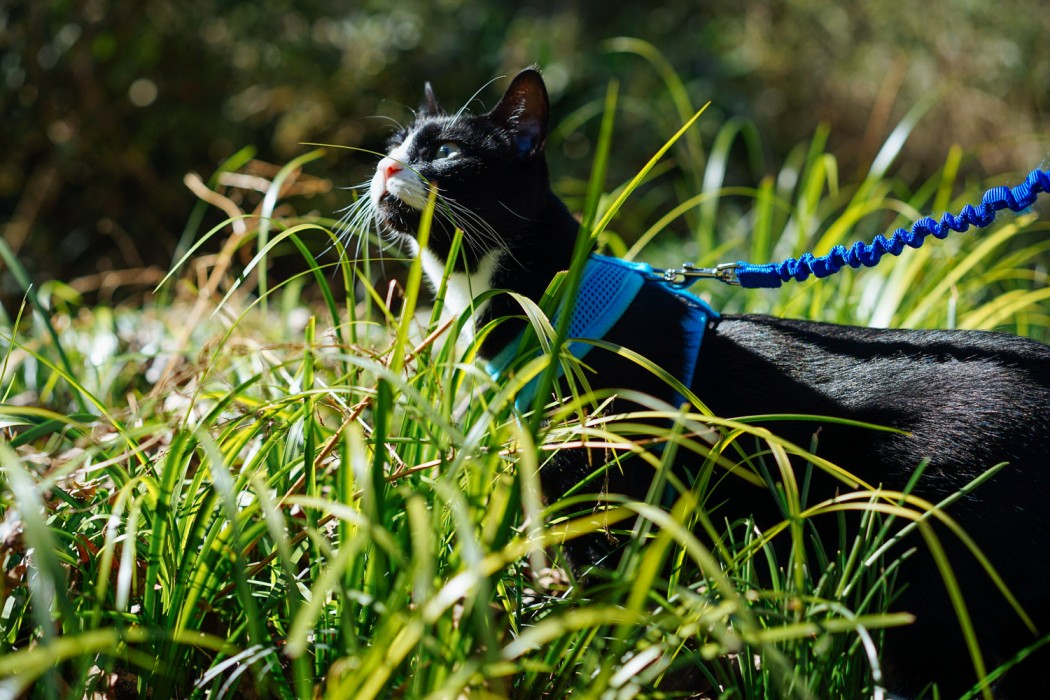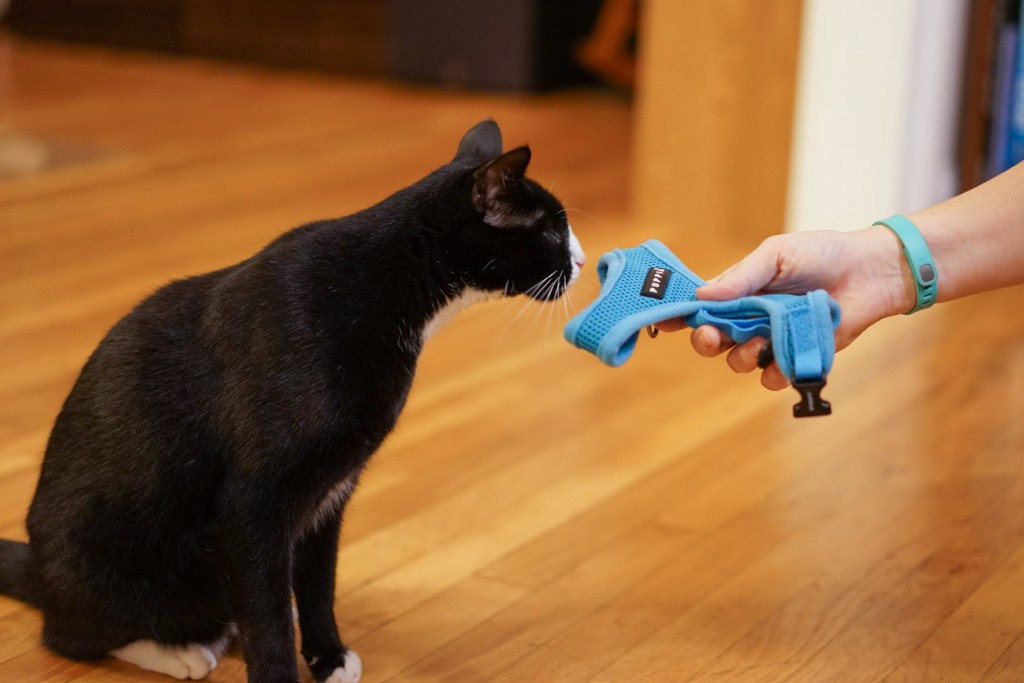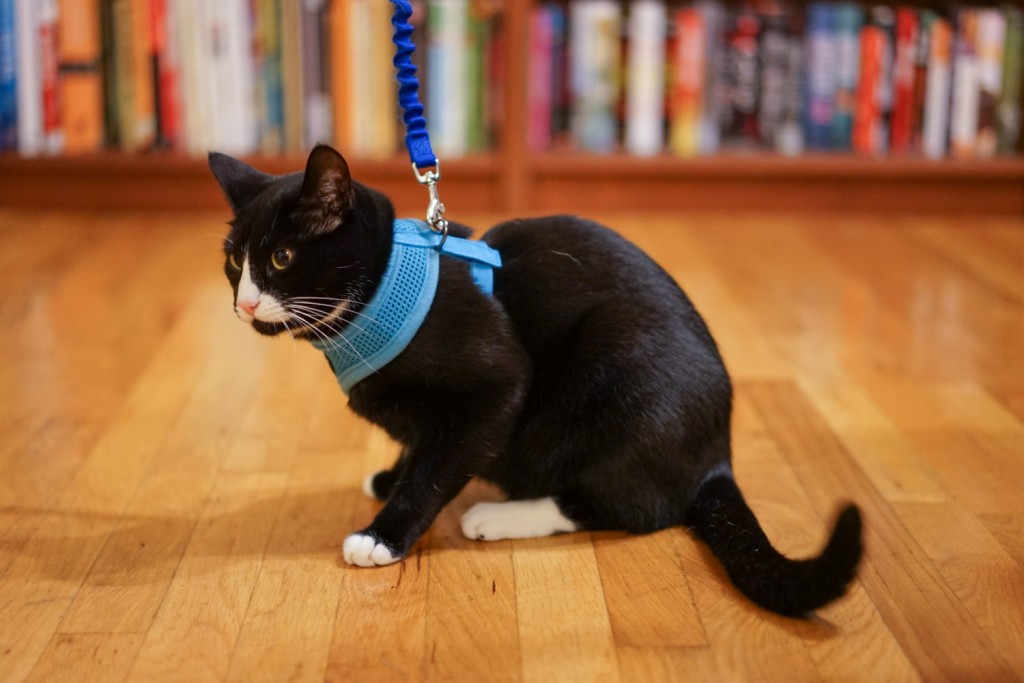If you want your kitty to join you on outdoor adventures — even if it’s just in the backyard or on the porch — you first need to find him a harness that fits comfortably and teach him to walk on a leash. Leash walking won’t only come in handy when you’re outside, but also when you’re traveling or taking your cat to the vet. It’s also a great way for your kitty to get exercise, and it can alleviate boredom-related behavior problems. Plus, it can be fun for both of you, if your kitty enjoys it.
“Walking outside can be great fun for cats — it gives them new things to see and sniff out,” veterinarian Dr. Frank McMillan, director of animal well-being studies at Best Friends Animal Society, told Adventure Cats. “If the cat isn’t comfortable on walks, there are some great strollers (like the ones we use extensively at Best Friends) that allow cats to see and smell things they don’t get to in the house.
“Think of it like this: If you could ask your cat every morning when you both wake up what he or she looks forward to that day, it’s often difficult to think of what the indoor-only cat might say. But it’s easy to imagine the response of the cat who goes outside on a harness and leash: ‘Our walk! Our walk!'”
Most cats can be trained to walk on a leash, but certain feline personalities are more accepting of new experiences like donning a harness and walking outdoors. The best time to introduce your cat to a harness is as a kitten because he’ll be naturally more accepting of it; however, older cats can also learn to walk on a leash if you’re patient and make leash training a positive experience.
However, keep in mind that walking on a leash and venturing outdoors isn’t for every cat. Some cats may never be comfortable on a leash or outdoors due to age, health or personality, and you should never force your pet outside of his comfort zone. You can still help your kitty stay happy, active and stimulated by having an indoor adventure!
If you think your cat is a good candidate for leash training, read on for tips on how to begin leash training your cat indoors.
Introduce the harness
The key to getting your cat used to a harness is making it a positive experience — and that means food. You can begin by leaving the harness by your cat’s food dish, or by simply holding out the harness so he can sniff it and then feeding him treats afterward.
New noises can be alarming to some cats, so practice snapping the harness together or undoing the Velcro to get your kitty accustomed to the new sounds.
Try it on
Now that your cat is aware of the harness, slip it on him, but don’t fasten it. Provide more treats as a distraction and to help your cat associate the harness with a positive experience.
“Put the harness on right before mealtime, so that the dinner distracts him from the new sensation and keeps him from focusing on removing it,” Dr. Kat Miller, director of ASPCA anti-cruelty behavior research, told Adventure Cats. “Do this several days in a row until he seems comfortable with it.”
If your cat is comfortable at this step, you can fasten the harness and practice adjusting the fit. You should be able to fit one or two fingers beneath the harness — but no more than that. Keep in mind that cats can back out of harness when they’re frightened, and you certainly don’t want your cat getting away from you outdoors.
Leave the harness on for a few minutes, and then provide another food reward. Do this for several days, paying attention to how your kitty reacts to the harness. If he seems comfortable in it, leave it on a bit longer, but if he gets upset, provide a food distraction and slip the harness off. Try again later with a better treat — perhaps some yummy canned food or tuna — and remove the harness sooner this time before your cat reacts negatively.
It’s completely normal for cats to freeze up, refuse to walk or walk very strangely the first few times they’re wearing a harness. Your cat has likely never experienced the sensation of something on his back before, so it’s going to take some time to adjust to it.
Attach the leash
It may take several days or even weeks to get your cat comfortable in the harness, but once your kitty is used to putting it on and walking normally, it’s time to attach the leash. (Again, if your cat doesn’t seem to adjust to the harness, that’s OK — have an indoor adventure instead!)
Take your cat into a room where he’s not likely to snag his leash on furniture or anything else, and then attach the leash. You may want to let the leash drag behind him as you feed him treats and engage him with toys, but a dragging leash can be alarming for some kitties. If this is the case, it’s best to hold the leash and let your cat wander freely.
When your cat is comfortable with the feel of the leash, practice following him around your home, keeping the leash loose in your hand. Continue to provide plenty of treats and praise throughout this process.
Once you’ve both had some practice with this, it’s time to try gently guiding your kitty. Apply a little pressure on the leash and call your cat to you. When he does, reward him with a treat. If you’ve done some clicker training, you can also use a clicker to reinforce that he’s performed a desired behavior.
“You want to make sure he does not freak out when he feels pressure on the leash holding him back and that he doesn’t wriggle his way out, leaving you holding a leash and empty harness as he dashes off. Again, do this several days in a row,” Miller said.
Learn more about leash training — including how to teach your cat to heel — from certified animal trainer Mikkel Becker in the video below.
Going outside
If the most your cat has interacted with the outdoors has been through the window, it’s likely he’s going to be on high alert when you take him outside for the first time so take things slowly.
Keep in mind that you don’t have to take your kitty far from home to help him get used to nature. You can start in your backyard — and if it’s fenced in, that’s even better.
First, pick up your harnessed kitty and carry him outside to a quiet area. Don’t let your cat walk out on the door on a leash or she may get used to doing so when she’s not leashed.
Stay beside him and let him decide when he’s ready to do a little exploring. Keep the leash loose and follow behind your cat, but don’t force him to venture farther than he’s ready.
“Until it’s clear that the cat is comfortable outside it’s a good idea to be prepared for a possible ‘freaking out’ episode if the cat becomes severely frightened,” said Dr. McMillan. “This means to carry a heavy towel that can be used to quickly wrap up the panicked cat without becoming scratched or bitten and bringing the cat inside. The first few trips outside should be near the door that leads back inside with the door open. In becoming accustomed to the outside the cat should know the he or she can seek safety back inside anytime things become overwhelming. After a few trips this will no longer be necessary.”
Keep in mind that walking a cat is different from walking a dog. While your cat may happily accompany you on long walks, it’s more likely that he may prefer to simply sniff around your yard and doze in the sun.
Regardless, it’s important to pay attention to what your cat is comfortable doing; don’t force him outside his comfort zone. Just like at home, your kitty is the one who’s calling the shots.
Additional leash-walking tips
Don’t let your leashed cat walk out the door on his own. Carry him outside every time.
“I always recommend that pet parents carry their cat outdoors, rather than letting the cat walk outdoors on his own,” Miller said. “The reason is to reduce the tendency for door-dashing when the leash is not on: A cat who is used to walking out of his own accord when the leash is on probably will try to do that at other times as well.”
Don’t put the harness on your cat when he’s pestering you for a walk.
“Don’t take your cat out when he is crying to go outside. Otherwise you’ll be rewarding the crying behavior and you will be hearing a lot more of that in the future,” Miller said.
Never leave your cat outside unattended.
Don’t tie your cat’s leash to something and leave him — not even if you plan to walk away for only a minute. Your kitty could become tangled in the leash and injure himself, and he won’t be able to escape from any approaching wildlife.
In the video below, watch how cat behaviorist Jackson Galaxy helped New York Times writer Stephanie Clifford teach her cat, Mac, to walk on a leash.
Before you take your cat outside, please familiarize yourself with these adventuring best practices.
For more information on leash training a cat, visit the ASPCA.
All photos: Cody Wellons







